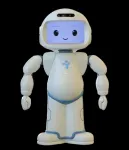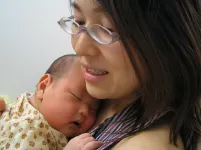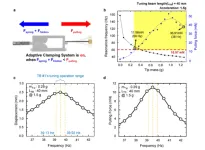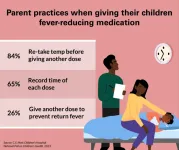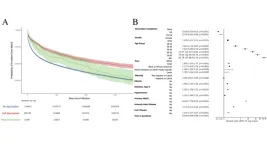(Press-News.org) Despite the fact that we all start out as an egg cell in one of our mother’s ovaries, these human reproductive organs are surprisingly under-studied. Scientists have been working on creating in vitro models of human ovaries so that we can learn more about them and develop treatments for ovarian conditions, but most existing models use a combination of human and mouse cells, which do not faithfully replicate human ovary functions and take a long time to grow in the lab.
Now, researchers at the Wyss Institute for Biologically Inspired Engineering at Harvard University, Harvard Medical School (HMS) and Duke University in collaboration with Gameto, a biotechnology company developing therapies to improve the female reproductive journey, have created a living, fully human ovarian organoid that supports egg cell maturation, develops follicles, and secretes sex hormones. This “ovaroid” model enables the study of human ovarian biology without the need to take tissue from patients, and could enable the development of new treatments for conditions like infertility, ovarian cancer, and more. Through an agreement with Harvard’s Office of Technology Development (OTD), this technology has been licensed to Gameto, which is using it to develop therapeutics for diseases of the female reproductive system. The ovaroids are described in detail in a new paper published today in eLife.
“Our new method of fully human ovaroid production is several times faster than existing human/mouse hybrid methods, and replicates many of the critical functions of these organs, marking a significant step forward in our ability to study female reproductive health in the lab. In the future, similar technology could also treat infertility by growing egg cells from people whose own eggs aren’t viable,” said co-first author Merrick Pierson Smela, a graduate student in the lab of George Church, Ph.D. at the Wyss Institute and HMS.
A supportive somatic scaffold from stem cells
The developing ovary contains both germ cells, which grow into egg cells, and somatic cells, which support the germ cells. Current lab models of ovaries use human germ cells and mouse somatic cells, but Smela and his co-authors wanted to see if they could coax human stem cells to grow into functional, fully human ovaries with both major cell types. They decided to focus their efforts on granulosa cells, a type of ovarian somatic cell that supports the development of unfertilized egg cells within follicles and secretes the sex hormones estradiol and progesterone. No method existed at the time for efficiently generating granulosa cells from human induced pluripotent stem cells (iPSCs), so they decided to create their own.
The burgeoning field of iPSC technology is based on the discovery that introducing proteins called transcription factors (TFs) - which bind directly to DNA and control whether certain genes are turned on or off - into human iPSCs can guide them to differentiate into different types of cells like neurons, fibroblasts, and many others. The team chose to pursue this strategy to produce human granulosa cells, and started by combing through datasets to identify TFs that are expressed differently in granulosa cells compared to other cell types. They found 35 candidate TFs, and used a technique called “piggyBac transposition” to insert the genes that coded for those TFs into the genomes of iPSCs.
After inducing the expression of their target TFs in the iPSCs, they screened the cells to see which ones also produced a protein called FOXL2, which is a known hallmark of granulosa cells. They identified six top TFs that were associated with FOXL2 expression: NR5A1, RUNX1/RUNX2, TCF21, GATA4, KLF2, and NR2F2. They then tested different combinations of these top candidates, and found that NR5A1 and either RUNX1 or RUNX2 consistently upregulated FOXL2. These combinations also drove the expression of two proteins called AMHR2 and CD82, which are surface markers found on granulosa cells.
The researchers then looked at the full transcriptome of their new cells, and found that they expressed a number of other genes that are known to be active in granulosa cells. Comparing their data with other studies of human fetal ovarian cells, they found that their cells were most similar in their gene expression to granulosa cells in a human ovary at 12 weeks of gestation – but had taken only five days to generate using their new method.
The team now needed to make sure that these new granulosa-like cells also replicated normal granulosa cell functions. One of those functions is the production of estradiol from the precursor molecule androstenedione, which is stimulated in the ovary by the presence of follicle-stimulating hormone (FSH). The researchers treated their granulosa-like cells with androstenedione, then added FSH. The cells successfully produced estradiol from androstenedione without the addition of FSH, and increased their production when FSH was added. They also produced progesterone, which granulosa cells secrete after ovulation.
100% human in 16% of the time
Now that they were confident that their granulosa-like cells functioned much like the real thing, the researchers co-cultured them with human primordial germ cell-like cells (hPGCLCs) to form ovarian organoids or “ovaroids” that included both germ cells and somatic cells.
“Creating the granulosa cells on their own was a significant accomplishment, but making an ovaroid out of only granulosa cells wouldn’t tell us anything about their ability to support the maturation of germ cells, which was what we wanted to be able to study in vitro,” said co-first author Christian Kramme, Ph.D., the Vice President of Cell Engineering at Gameto and a former graduate student in Church’s group at the Wyss Institute and HMS. “This process had been replicated previously using hPGCLCs and mouse somatic cells, but with this new technology, we now have the ability to do it with a fully human model.”
After four days of co-culturing their granulosa-like cells with hPGCLCs, the resulting ovaroids started to produce a protein called DAZL, which is a marker of germ cells that have embarked on their maturation journey. In contrast, ovaroids made with mouse somatic cells did not express DAZL until day 32. The human germ cells did not live long enough to develop further into egg cells, but the human ovaroids started to form empty, follicle-like structures composed of the granulosa-like cells after about 16 days, despite the fact that there were no egg cells present. By day 70, numerous follicles of varying sizes had formed within the ovaroids, some of which had developed multiple layers characteristic of mature follicles that are capable of supporting an egg.
“The efficient production of fully human ovaroids that replicate the hormonal signaling, germ cell maturation, and follicle formation seen in the human ovary is a feat in and of itself, but the fact that this can be done within five days instead of the month required with human/mouse hybrid ovaroids will dramatically speed up the discovery of critical information about women’s health and reproduction,” said senior author Church, who is a Core Faculty Member at the Wyss Institute as well as a Professor of Genetics at HMS.
The Wyss team is continuing to develop its human ovaroid model and plans to integrate additional ovarian cell types, including hormone-producing theca cells, to more fully replicate the complex functions of the human ovary. They also hope to improve their culture system to allow their germ cells to fully develop into egg cells, and determine the optimal dosage of the different TFs. Gameto, meanwhile, has conducted preclinical studies of a derived co-culture system for egg maturation in humans with leading national fertility clinics.
“Half of the human population is female, and yet historically women’s health has not received anywhere near the attention or funding that is given to conditions that affect men. I’m very excited to see this important step forward in being able to study human ovaries in the lab, and look forward to the insights that such a model will provide about female reproductive health and disease,” said Wyss Founding Director Don Ingber, M.D., Ph.D. Ingber is also the Judah Folkman Professor of Vascular Biology at HMS and Boston Children’s Hospital, and the Hansjörg Wyss Professor of Bioinspired Engineering at the Harvard John A. Paulson School of Engineering and Applied Sciences.
Additional authors of the paper include Patrick Fortuna, Jessica Adams, Alina Su, and Edward Dong from the Wyss Institute; Mutsumi Kobayashi, Toshi Shioda, and Garyk Brixi from HMS; Pranam Chatterjee from Duke University; Emma Tysinger from MIT; and former Wyss Institute member Richie Kohman, who is now CSO of the Wyss Center for Bio and Neuroengineering.
This research was supported by the Wyss Institute at Harvard University, Harvard OTD, sponsored research agreements between the Wyss Institute and industry partners Gameto and Colossal, and the National Science Foundation.
END
Gameto licenses Wyss Institute tech to grow human ovaries in the lab
First fully human ovarian organoids could be used to develop new treatments for women’s reproductive health
2023-02-21
ELSE PRESS RELEASES FROM THIS DATE:
Robot helps students with learning disabilities stay focused
2023-02-21
Engineering researchers at the University of Waterloo are successfully using a robot to help keep children with learning disabilities focused on their work.
This was one of the key results in a new study that also found both the youngsters and their instructors valued the positive classroom contributions made by the robot.
“There is definitely a great potential for using robots in the public education system,” said Dr. Kerstin Dautenhahn, a professor of electrical and computer engineering. “Overall, the findings imply ...
Most babies born to mothers with COVID-19 separated after birth resulting in low breastfeeding rates
2023-02-21
Most babies born to mothers with COVID-19 were separated after birth resulting in low breastfeeding and skin-to-skin contact rates during the height of the pandemic, according to a new global study.
The international research, led by Murdoch Children’s Research Institute in collaboration with the the European Society of Paediatric and Neonatal Intensive Care (ESPNIC), found that transmission of COVID-19 from mother to baby was rare and generally mild when it occurred. But despite this, almost half of all babies did not receive any breast milk, with ...
Cohesion and connection drop in ageing population
2023-02-20
Social cohesion and connection decline in an ageing population, according to a new study of one of humanity’s closest relatives.
For decades, researchers have been observing the rhesus macaques on Cayo Santiago (known as “Monkey Island”) in Puerto Rico.
Recent research showed that female macaques “actively reduce” the size of their social networks and prioritise existing connections as they age – something also seen in humans.
The new study, by an international team led by the University of Exeter, examines how this affects the overall cohesion and connection of the groups older monkeys live in.
While ...
Development of a self-resonant smart energy harvester
2023-02-20
The Internet of Things (IoT) requires the installation free of time and space, therefore, needs independent power sources that are not restricted by batteries or power lines. Energy harvesting technology harvests wasted energy such as vibration, heat, light, and electromagnetic waves from everyday settings, such as automobiles, buildings, and home appliances, and converts it into electrical energy. Energy harvesters can generate sufficient electricity to run small electronic devices by harvesting ambient energy sources without an external power supply.
The Korea Institute of Science and Technology (KIST, President Seok Jin Yoon) announced ...
1 in 3 parents may unnecessarily give children fever-reducing medicine
2023-02-20
For many children, winter season comes with regular exposure to circulating viruses at school or daycare. And a warm forehead is often one of the first clear signs a child has caught a bug.
But some parents may not be properly measuring or responding to elevated temperatures in children, a new national poll suggests.
While most parents recognize that a low-grade fever helps a child’s body fight off infection, one in three would give fever-reducing medication for spiked temperatures below 100.4 – which isn’t recommended – according to the C.S. Mott Children’s Hospital National Poll on Children’s Health at University of Michigan Health.
Half of parents ...
Correspondence shows troubling interactions between US officials and the alcohol industry
2023-02-20
Correspondence shows troubling interactions between U.S. officials and the alcohol industry
By Kimberly Flynn
PISCATAWAY, NJ — Growing evidence exists that the alcohol industry uses a variety of strategies to influence public policy in a way that is advantageous to its own corporate interests, rather than the interest of public health. Recent communication between employees of the National Institute on Alcohol Abuse and Alcoholism (NIAAA) and alcohol industry groups shows extensive interaction on policy-relevant scientific issues, according to a new study in the Journal of Studies on Alcohol and Drugs.
Researchers at the University ...
COVID-19 vaccination linked to fewer cardiac events
2023-02-20
New York, NY [February 20, 2023] – Analyzing the most extensive datasets in the United States, researchers from the Icahn School of Medicine at Mount Sinai have revealed that vaccination against COVID-19 is associated with fewer heart attacks, strokes, and other cardiovascular issues among people who were infected with SARS-CoV-2, the virus that causes COVID-19.
The research letter, “Impact of Vaccination on Major Adverse Cardiovascular Events in Patients with COVID-19 Infection,” was published in the Journal of the American College ...
Pathways of memory: anthropological poetry at SAPIENS magazine
2023-02-20
Contact: Chip Colwell
chip@sapiens.org
212.683.5000
New York, NY – SAPIENS magazine is excited to share news of its 2023 poet-in-residence: Toiba Naseema. Through this position, Naseema will use poetry, film, and music to reflect on memory, occupation, and resilience in Indian-occupied Kashmir.
Naseema earned a master’s degree in mass communication, specializing in documentary filmmaking, and she is currently pursuing a master’s in anthropology at the University of Kashmir. She has been involved as an international ...
No safety concerns seen with use of dapivirine vaginal ring during third trimester of pregnancy, according to interim results of DELIVER study
2023-02-20
A vaginal ring containing the antiretroviral drug dapivirine posed no safety concerns when used in the third trimester of pregnancy, according to results to date from the first study of the dapivirine ring during pregnancy and one of only a few studies of an HIV prevention product in pregnant cisgender women.
The ongoing Phase IIIb study, known as DELIVER, or MTN-042, was designed to evaluate the safety and acceptability of the monthly dapivirine vaginal ring, a new HIV prevention method approved in several African countries and recommended by the World Health Organization (WHO), as well as ...
Doxycycline does not prevent STIs among cisgender women
2023-02-20
February 20, 2023 – Researchers from the University of Washington (UW), Kenya Medical Research Institute (KEMRI), and Hennepin Healthcare Research Institute (HHRI) announced results at CROI from a clinical trial demonstrating that doxycycline taken after sex does not prevent bacterial sexually transmitted infections (STIs) – chlamydia or gonorrhea – among cisgender women. The dPEP Kenya Trial was conducted in Kisumu, Kenya, to evaluate the effectiveness of doxycycline postexposure prophylaxis (PEP) to prevent bacterial STIs. The results of the study have been highly anticipated, as this is the first study of doxycycline PEP among cisgender ...
LAST 30 PRESS RELEASES:
Statins significantly reduce mortality risk for adults with diabetes, regardless of cardiovascular risk
Brain immune cells may drive more damage in females than males with Alzheimer’s
Evidence-based recommendations empower clinicians to manage epilepsy in pregnancy
Fungus turns bark beetles’ defenses against them
There are new antivirals being tested for herpesviruses. Scientists now know how they work
CDI scientist, colleagues author review of global burden of fungus Candida auris
How does stroke influence speech comprehension?
B cells transiently unlock their plasticity, risking lymphoma development
Advanced AI dodel predicts spoken language outcomes in deaf children after cochlear implants
Multimodal imaging-based cerebral blood flow prediction model development in simulated microgravity
Accelerated streaming subgraph matching framework is faster, more robust, and scalable
Gestational diabetes rose every year in the US since 2016
OHSU researchers find breast cancer drug boosts leukemia treatment
Fear and medical misinformation regarding risk of progression or recurrence among patients with breast cancer
Glucagonlike peptide-1 receptor agonists and asthma risk in adolescents with obesity
Reviving dormant immunity: Millimeter waves reprogram the immunosuppressive microenvironment to potentiate immunotherapy without obvious side effects
Safety decision-making for autonomous vehicles integrating passenger physiological states by fNIRS
Fires could emit more air pollution than previously estimated
A new way to map how cells choose their fate
Numbers in our sights affect how we perceive space
SIMJ announces global collaborative book project in commemoration of its 75th anniversary
Air pollution exposure and birth weight
Obstructive sleep apnea risk and mental health conditions among older adults
How talking slows eye movements behind the wheel
The Ceramic Society of Japan’s Oxoate Ceramics Research Association launches new international book project
Heart-brain connection: international study reveals the role of the vagus nerve in keeping the heart young
Researchers identify Rb1 as a predictive biomarker for a new therapeutic strategy in some breast cancers
Survey reveals ethical gaps slowing AI adoption in pediatric surgery
Stimulant ADHD medications work differently than thought
AI overestimates how smart people are, according to HSE economists
[Press-News.org] Gameto licenses Wyss Institute tech to grow human ovaries in the labFirst fully human ovarian organoids could be used to develop new treatments for women’s reproductive health
